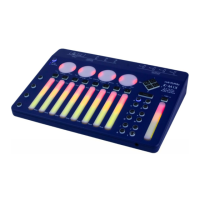FEATURES OVERVIEW
28
This section is a general overview of the deep feature set offered by K-Mix — what they are, what they do,
and what can be adjusted. It does not discuss how these features are controlled, it merely provides a brief
introduction. The exact manner in which these features are accessed/adjusted via the K-Mix hardware and the
K-Mix Editor will be discussed in the two subsequent sections: K-Mix Hardware and K-Mix Editor.
3.1 – STANDALONE MIXING
K-Mix can function as a traditional standalone mixer; no computer necessary. Power K-Mix via a USB power
supply and you’re good to go. Audio coming into the inputs can leverage K-Mix’s onboard DSP effects and
exible output routing, allowing you to mix your gear wherever there’s access to power.
3.2 – USB AUDIO INTERFACE
In addition to being a standalone mixer, K-Mix can also act as an 8-input, 10-output USB bus-powered audio
interface.
• Audio coming into the mixer can be sent up USB to a connected computer for recording or further
processing.
• Audio from a connected computer can be sent directly out of K-Mix’s outputs or through K-Mix’s channel
strip effects.
• USB pre/post switches allow for exible routing of USB audio into and out of K-Mix.
3.3 – MIDI I/O
In addition to functioning as both a mixer and audio interface, K-Mix speaks MIDI. K-Mix allows for bi-
directional MIDI communication with USB host devices (computer, tablet), and with external MIDI hardware
(via the optional KMI MIDI Expander). K-Mix is fully capable of both outputting MIDI to control other devices/
software, and receiving MIDI for control of its own parameters.
• K-Mix features three MIDI banks; each fader, rotary, and button can be set to output completely different
MIDI messages for each bank.
• When connected to a computer, MIDI can be sent from the computer to K-Mix for controlling nearly all of
K-Mix’s audio parameters; this allows for fully automating your K-Mix!
• When using K-Mix with the optional KMI MIDI Expander, MIDI coming into the Expander can also be used
to control K-Mix’s audio parameters, allowing you to control K-Mix from external MIDI hardware.
K-Mix’s MIDI capabilities allow for very powerful, highly customizable interactions. More in-depth information
about using K-Mix and MIDI together can be found in section 4.3 – MIDI & K-Mix.

